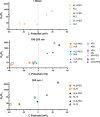Diffusion and Protein Corona Formation of Lipid-Based Nanoparticles in the Vitreous Humor: Profiling and Pharmacokinetic Considerations
- PMID: 32584047
- PMCID: PMC7856631
- DOI: 10.1021/acs.molpharmaceut.0c00411
Diffusion and Protein Corona Formation of Lipid-Based Nanoparticles in the Vitreous Humor: Profiling and Pharmacokinetic Considerations
Abstract
The vitreous humor is the first barrier encountered by intravitreally injected nanoparticles. Lipid-based nanoparticles in the vitreous are studied by evaluating their diffusion with single-particle tracking technology and by characterizing their protein coronae with surface plasmon resonance and high-resolution proteomics. Single-particle tracking results indicate that the vitreal mobility of the formulations is dependent on their charge. Anionic and neutral formulations are mobile, whereas larger (>200 nm) neutral particles have restricted diffusion, and cationic particles are immobilized in the vitreous. PEGylation increases the mobility of cationic and larger neutral formulations but does not affect anionic and smaller neutral particles. Convection has a significant role in the pharmacokinetics of nanoparticles, whereas diffusion drives the transport of antibodies. Surface plasmon resonance studies determine that the vitreal corona of anionic formulations is sparse. Proteomics data reveals 76 differentially abundant proteins, whose enrichment is specific to either the hard or the soft corona. PEGylation does not affect protein enrichment. This suggests that protein-specific rather than formulation-specific factors are drivers of protein adsorption on nanoparticles in the vitreous. In summary, our findings contribute to understanding the pharmacokinetics of nanoparticles in the vitreous and help advance the development of nanoparticle-based treatments for eye diseases.
Keywords: lipid-based nanoparticle; ocular pharmacokinetics; protein corona; proteomics; single-particle tracking; vitreal diffusion.
Conflict of interest statement
The authors declare no competing financial interest.
Figures




Similar articles
-
The diffusion dynamics of PEGylated liposomes in the intact vitreous of the ex vivo porcine eye: A fluorescence correlation spectroscopy and biodistribution study.Int J Pharm. 2017 Apr 30;522(1-2):90-97. doi: 10.1016/j.ijpharm.2017.03.003. Epub 2017 Mar 4. Int J Pharm. 2017. PMID: 28267579
-
Measuring the intravitreal mobility of nanomedicines with single-particle tracking microscopy.Nanomedicine (Lond). 2013 Dec;8(12):1955-68. doi: 10.2217/nnm.12.202. Epub 2013 Feb 26. Nanomedicine (Lond). 2013. PMID: 23438206
-
Nanoparticle-protein complexes mimicking corona formation in ocular environment.Biomaterials. 2016 Dec;109:23-31. doi: 10.1016/j.biomaterials.2016.09.008. Epub 2016 Sep 13. Biomaterials. 2016. PMID: 27648757
-
How Corona Formation Impacts Nanomaterials as Drug Carriers.Mol Pharm. 2020 Mar 2;17(3):725-737. doi: 10.1021/acs.molpharmaceut.9b01111. Epub 2020 Jan 24. Mol Pharm. 2020. PMID: 31939673 Review.
-
The vitreous humor as a barrier to nanoparticle distribution.J Ocul Pharmacol Ther. 2013 Mar;29(2):143-50. doi: 10.1089/jop.2012.0138. Epub 2012 Oct 31. J Ocul Pharmacol Ther. 2013. PMID: 23113646 Review.
Cited by
-
Doxorubicin-loaded DNA origami nanostructures: stability in vitreous and their uptake and toxicity in ocular cells.Nanoscale. 2024 Sep 26;16(37):17585-17598. doi: 10.1039/d4nr01995d. Nanoscale. 2024. PMID: 39228361 Free PMC article.
-
Pullulan Based Bioconjugates for Ocular Dexamethasone Delivery.Pharmaceutics. 2021 May 26;13(6):791. doi: 10.3390/pharmaceutics13060791. Pharmaceutics. 2021. PMID: 34073275 Free PMC article.
-
Diffusion of nanoparticles in heterogeneous hydrogels as vitreous humour in vitro substitutes.Sci Rep. 2024 Jul 29;14(1):17441. doi: 10.1038/s41598-024-68267-0. Sci Rep. 2024. PMID: 39075157 Free PMC article.
-
Kavain Alleviates Choroidal Neovascularization Via Decreasing the Activity of the HIF-1α/VEGF-A/VEGFR2 Signaling Pathway and Inhibiting Inflammation.Adv Pharm Bull. 2024 Jul;14(2):469-482. doi: 10.34172/apb.2024.036. Epub 2024 Mar 11. Adv Pharm Bull. 2024. PMID: 39206403 Free PMC article.
-
Hybrid NIR-responsive liposome/hydrogel platform mediating chemo-photothermal therapy of retinoblastoma enhanced by quercetin as an adjuvant.Theranostics. 2025 Mar 10;15(9):3995-4015. doi: 10.7150/thno.108471. eCollection 2025. Theranostics. 2025. PMID: 40213657 Free PMC article.
References
-
- del Amo E. M.; Rimpelä A.-K.; Heikkinen E.; Kari O. K.; Ramsay E.; Lajunen T.; Schmitt M.; Pelkonen L.; Bhattacharya M.; Richardson D.; Subrizi A.; Turunen T.; Reinisalo M.; Itkonen J.; Toropainen E.; Casteleijn M.; Kidron H.; Antopolsky M.; Vellonen K.-S.; Ruponen M.; Urtti A. Pharmacokinetic Aspects of Retinal Drug Delivery. Prog. Retinal Eye Res. 2017, 57, 134–185. 10.1016/j.preteyeres.2016.12.001. - DOI - PubMed
Publication types
MeSH terms
Substances
LinkOut - more resources
Full Text Sources
Medical

